Global Trends in the Research and Development of Petrochemical Waste Gas from 1981 to 2022
Abstract
:1. Introduction
2. Data Sources and Analysis Methods
2.1. Data Sources
2.2. Analysis Methods
3. Results and Discussion
3.1. Contributions of Top Producers
3.1.1. Global Research Situation
3.1.2. Contribution of Institutions and Journals
3.2. Scientific Research Cooperation
3.2.1. Analysis of Cooperation Networks across Countries
3.2.2. Analysis of Cooperation Networks across Institutions
3.2.3. Analysis of Author Cooperation Networks
3.2.4. Document Co-Citation Analysis
3.3. Research Hotspots and Emerging Trends in PWG
3.3.1. Research Hotspots
3.3.2. Emerging Trends
- 1.
- Automatic supervisory control
- 2.
- Improve process efficiency
- 3.
- Low-carbon sustainable development
- 4.
- Adsorption gas filtration technology
4. Discussion and Conclusions
4.1. Future Research Directions
4.2. Policy Recommendations
4.3. Limitations
4.4. Conclusions
Supplementary Materials
Author Contributions
Funding
Data Availability Statement
Conflicts of Interest
References
- Geng, Z.Q.; Zhang, Y.H.; Li, C.F.; Han, Y.M.; Cui, Y.F.; Yu, B. Energy optimization and prediction modeling of petrochemical industries: An improved convolutional neural network based on cross-feature. Energy 2020, 194, 10. [Google Scholar] [CrossRef]
- Jafarinejad, S.; Jiang, S.C. Current technologies and future directions for treating petroleum refineries and petrochemical plants (PRPP) wastewaters. J. Environ. Chem. Eng. 2019, 7, 11. [Google Scholar] [CrossRef]
- Fagerlund, J.; Zevenhoven, R.; Thomassen, J.; Tednes, M.; Abdollahi, F.; Thomas, L.; Nielsen, C.J.; Mikoviny, T.; Wisthaler, A.; Zhu, L.; et al. Performance of an amine-based CO2 capture pilot plant at the Fortum Oslo Varme Waste to Energy plant in Oslo, Norway. Int. J. Greenh. Gas Control 2021, 106, 14. [Google Scholar] [CrossRef]
- Liu, Y.R.; Yang, M.L.; Ding, Y.X.; Wang, M.H.; Qian, F. Process modelling, optimisation and analysis of heat recovery energy system for petrochemical industry. J. Clean. Prod. 2022, 381, 18. [Google Scholar] [CrossRef]
- Zhou, X.; Yang, Q.C.; Yang, S.Q.; Yan, H.; Feng, X.; Liu, Y.B.; Zhao, H.; Wang, H.Z.; Chen, D.; Chen, X.B.; et al. One-step leap in achieving oil-to-chemicals by using a two-stage riser reactor: Molecular-level process model and multi-objective optimization strategy. Chem. Eng. J. 2022, 444, 20. [Google Scholar] [CrossRef]
- Zhao, Y.; Wang, S. Promoting the prevention and control strategy of tuberculosis scientifically to achieve “the 13th Five-year Plan” for tuberculosis control program. Chin. J. Dis. Control Prev. 2017, 21, 431. [Google Scholar]
- Sarkar, C.; Wong, G.; Mielnik, A.; Nagalingam, S.; Gross, N.J.; Guenther, A.B.; Lee, T.; Park, T.; Ban, J.; Kang, S.; et al. Unexplored volatile organic compound emitted from petrochemical facilities: Implications for ozone production and atmospheric chemistry. Atmos. Chem. Phys. 2021, 21, 11505–11518. [Google Scholar] [CrossRef]
- Santosa, D.M.; Kutnyakov, I.; Flake, M.; Wang, H.M. Coprocessing Biomass Fast Pyrolysis and Catalytic Fast Pyrolysis Oils with Vacuum Gas Oil in Refinery Hydroprocessing. Energy Fuels 2022, 36, 12641–12650. [Google Scholar] [CrossRef]
- Naraki, H.; Keshavarzi, B.; Zarei, M.; Moore, F.; Abbasi, S.; Kelly, F.J.; Dominguez, A.O.; Jaafarzadeh, N. Urban street dust in the Middle East oldest oil refinery zone: Oxidative potential, source apportionment and health risk assessment of potentially toxic elements. Chemosphere 2021, 268, 128825. [Google Scholar] [CrossRef]
- Zhang, Z.Y.; Yang, W.Y.; Zhang, S.C.; Chen, L. Impacts of Pollutant Emissions from Typical Petrochemical Enterprises on Air Quality in the North China Plain. Atmosphere 2023, 14, 15. [Google Scholar] [CrossRef]
- Huang, L.; Chen, K.; Zhou, M. Climate change and carbon sink: A bibliometric analysis. Environ. Sci. Pollut. Res. 2020, 27, 8740–8758. [Google Scholar] [CrossRef] [PubMed]
- Griffin, P.W.; Hammond, G.P.; Norman, J.B. Industrial energy use and carbon emissions reduction in the chemicals sector: A UK perspective. Appl. Energy 2018, 227, 587–602. [Google Scholar] [CrossRef]
- Gerres, T.; Avila, J.P.C.; Llamas, P.L.; San Román, T.G. A review of cross-sector decarbonisation potentials in the European energy intensive industry. J. Clean. Prod. 2019, 210, 585–601. [Google Scholar] [CrossRef]
- de Carvalho, A.L.; Antunes, C.H.; Freire, F. Economic-energy-environment analysis of prospective sugarcane bioethanol production in Brazil. Appl. Energy 2016, 181, 514–526. [Google Scholar] [CrossRef]
- Kätelhön, A.; Meys, R.; Deutz, S.; Suh, S.; Bardow, A. Climate change mitigation potential of carbon capture and utilization in the chemical industry. Proc. Natl. Acad. Sci. USA 2019, 116, 11187–11194. [Google Scholar] [CrossRef] [PubMed]
- Gabrielli, P.; Gazzani, M.; Mazzotti, M. The Role of Carbon Capture and Utilization, Carbon Capture and Storage, and Biomass to Enable a Net-Zero-CO2 Emissions Chemical Industry. Ind. Eng. Chem. Res. 2020, 59, 7033–7045. [Google Scholar] [CrossRef]
- Wang, L.; Xu, Y.X.; Qin, T.; Wu, M.T.; Chen, Z.Q.; Zhang, Y.L.; Liu, W.; Xie, X.C. Global trends in the research and development of medical/pharmaceutical wastewater treatment over the half-century. Chemosphere 2023, 331, 18. [Google Scholar] [CrossRef] [PubMed]
- Wei, F.W.; Grubesic, T.H.; Bishop, B.W. Exploring the GIS Knowledge Domain Using CiteSpace. Prof. Geogr. 2015, 67, 374–384. [Google Scholar] [CrossRef]
- Fang, Y.; Yin, J.; Wu, B.H. Climate change and tourism: A scientometric analysis using CiteSpace. J. Sustain. Tour. 2018, 26, 108–126. [Google Scholar] [CrossRef]
- Holmgren, K.; Sternhufvud, C. CO2-emission reduction costs for petroleum refineries in Sweden. J. Clean. Prod. 2008, 16, 385–394. [Google Scholar] [CrossRef]
- Lin, B.Q.; Wang, M. Dynamic analysis of carbon dioxide emissions in China’s petroleum refining and coking industry. Sci. Total Environ. 2019, 671, 937–947. [Google Scholar] [CrossRef]
- Liu, G.X.; Wu, M.; Jia, F.R.; Yue, Q.; Wang, H.M. Material Flow and Spatial Data Analysis of the Petroleum Use to Carbon Dioxide (CO2) Emissions in Northeast China. J. Ind. Ecol. 2019, 23, 823–837. [Google Scholar] [CrossRef]
- Pan, Y.; Bai, J.; Yang, G.; Li, Z. Progress in the Research on Branched Polymers with Emphasis on the Chinese Petrochemical Industry. Molecules 2023, 28, 7934. [Google Scholar] [CrossRef] [PubMed]
- Al-Qahtani, A.; González-Garay, A.; Bernardi, A.; Galán-Martín, A.; Pozo, C.; Mac Dowell, N.; Chachuat, B.; Guillén-Gosálbez, G. Electricity grid decarbonisation or green methanol fuel? A life-cycle modelling and analysis of today’s transportation-power nexus. Appl. Energy 2020, 265, 9. [Google Scholar] [CrossRef]
- Liu, Z.; Qiu, Z.W. A systematic review of transportation carbon emissions based on CiteSpace. Environ. Sci. Pollut. Res. 2023, 30, 54362–54384. [Google Scholar] [CrossRef] [PubMed]
- Fultz, M.; Stone, D.; Clendenin, W.V. The birth of the petrochemical industry. Abstr. Pap. Am. Chem. Soc. 2019, 257, 1. [Google Scholar]
- Sedriks, W. Petrochemical Industry Drivers. Chemtech 1995, 25, 56–60. [Google Scholar]
- Shukla, M.M.; Shukla, A.K. A Look into the Petrochemicals Industry. Am. Lab. 2012, 44, 16–18. [Google Scholar]
- Bukhari, M.A.I.; Veres, G. Development of an experimental apparatus for the measurement of the thermodynamic properties of CO2-contaminated natural gases.1. Acta Tech. Acad. Sci. Hung. 1981, 92, 383–392. [Google Scholar]
- Malik, M.A.; Jiang, X.Z. The CO2 reforming of natural gas in a pulsed corona discharge reactor. Plasma Chem. Plasma Process. 1999, 19, 505–512. [Google Scholar] [CrossRef]
- Jephcote, C.; Mah, A. Regional inequalities in benzene exposures across the European petrochemical industry: A Bayesian multilevel modelling approach. Environ. Int. 2019, 132, 17. [Google Scholar] [CrossRef] [PubMed]
- Farashah, V.H.; Sazvar, Z.; Hosseini, S.H. A dynamic model to formulate effective capacity expansion policies in Iranian petrochemical Industry to complete the value chain. Energy Policy 2021, 148, 12. [Google Scholar] [CrossRef]
- Mohammadi, A.; Soltanieh, M.; Abbaspour, M.; Atabi, F. What is energy efficiency and emission reduction potential in the Iranian petrochemical industry? Int. J. Greenh. Gas Control 2013, 12, 460–471. [Google Scholar] [CrossRef]
- Barjoee, S.S.; Dashtian, A.H.; Keykhosravi, S.S.; Saryazdi, M.J.A.; Afrough, M.J. Modeling the environmental, health, and safety aspects of xylene isomer emission from storage tanks in petrochemical industries, Iran. Environ. Monit. Assess. 2021, 193, 25. [Google Scholar] [CrossRef]
- Cui, Z.; Sun, S.; Zhang, H.; Liu, B.; Tian, W.; Guo, Q. Comprehensive optimization of coal chemical looping gasification process for low CO2 emission based on multi-scale simulation coupled experiment. Fuel 2022, 324, 11. [Google Scholar] [CrossRef]
- Dong, K.Y.; Sun, R.J.; Hochman, G.; Zeng, X.H.; Li, H.; Jiang, H.D. Impact of natural gas consumption on CO2 emissions: Panel data evidence from China’s provinces. J. Clean. Prod. 2017, 162, 400–410. [Google Scholar] [CrossRef]
- Dong, K.Y.; Sun, R.J.; Li, H.; Liao, H. Does natural gas consumption mitigate CO2 emissions: Testing the environmental Kuznets curve hypothesis for 14 Asia-Pacific countries. Renew. Sust. Energ. Rev. 2018, 94, 419–429. [Google Scholar] [CrossRef]
- Ke, J.; Li, S.; Zhao, D.F. The application of leak detection and repair program in VOCs control in China’s petroleum refineries. J. Air Waste Manage. Assoc. 2020, 70, 862–875. [Google Scholar] [CrossRef]
- Biswal, T.; Shadangi, K.P.; Sarangi, P.K.; Srivastava, R.K. Conversion of carbon dioxide to methanol: A comprehensive review. Chemosphere 2022, 298, 20. [Google Scholar] [CrossRef]
- Elgowainy, A.; Han, J.; Cai, H.; Wang, M.; Forman, G.S.; DiVita, V.B. Energy Efficiency and Greenhouse Gas Emission Intensity of Petroleum Products at US Refineries. Environ. Sci. Technol. 2014, 48, 7612–7624. [Google Scholar] [CrossRef]
- Ramírez, N.; Cuadras, A.; Rovira, E.; Borrull, F.; Marcé, R.M. Chronic risk assessment of exposure to volatile organic compounds in the atmosphere near the largest Mediterranean industrial site. Environ. Int. 2012, 39, 200–209. [Google Scholar] [CrossRef] [PubMed]
- Sun, P.P.; Young, B.; Elgowainy, A.; Lu, Z.F.; Wang, M.; Morelli, B.; Hawkins, T. Criteria Air Pollutant and Greenhouse Gases Emissions from US Refineries Allocated to Refinery Products. Environ. Sci. Technol. 2019, 53, 6556–6569. [Google Scholar] [CrossRef] [PubMed]
- Mohammed, S.A.S.; Yahya, W.Z.N.; Bustam, M.A.; Kibria, M.G. Elucidation of the Roles of Ionic Liquid in CO2 Electrochemical Reduction to Value-Added Chemicals and Fuels. Molecules 2021, 26, 23. [Google Scholar] [CrossRef] [PubMed]
- Liu, G.P.; Chernikova, V.; Liu, Y.; Zhang, K.; Belmabkhout, Y.; Shekhah, O.; Zhang, C.; Yi, S.L.; Eddaoudi, M.; Koros, W.J. Mixed matrix formulations with MOF molecular sieving for key energy-intensive separations (vol 17, pg 283, 2018). Nat. Mater. 2021, 20, 1037. [Google Scholar] [CrossRef]
- Liu, Y.; Liu, Z.Y.; Kraftschik, B.E.; Babu, V.P.; Bhuwania, N.; Chinn, D.; Koros, W.J. Natural gas sweetening using TEGMC polyimide hollow fiber membranes. J. Membr. Sci. 2021, 632, 6. [Google Scholar] [CrossRef]
- Quan, W.; Holmes, H.E.; Zhang, F.; Hamlett, B.L.; Finn, M.G.; Abney, C.W.; Kapelewski, M.T.; Weston, S.C.; Lively, R.P.; Koros, W.J. Scalable Formation of Diamine-Appended Metal-Organic Framework Hollow Fiber Sorbents for Postcombustion CO2 Capture. JACS Au 2022, 2, 1350–1358. [Google Scholar] [CrossRef] [PubMed]
- Belal, B.Y.; Li, G.S.; Zhang, Z.H.; El-Batsh, H.M.; Moneib, H.A.; Attia, A.M.A. The effect of swirl burner design configuration on combustion and emission characteristics of lean pre-vaporized premixed flames. Energy 2021, 228, 13. [Google Scholar] [CrossRef]
- Fan, J.M.; Hong, H.; Jin, H.G. Life cycle global warming impact of CO2 capture by in-situ gasification chemical looping combustion using ilmenite oxygen carriers. J. Clean. Prod. 2019, 234, 568–578. [Google Scholar] [CrossRef]
- Zhao, Y.; Wang, S.X.; Duan, L.; Lei, Y.; Cao, P.F.; Hao, J.M. Primary air pollutant emissions of coal-fired power plants in China: Current status and future prediction. Atmos. Environ. 2008, 42, 8442–8452. [Google Scholar] [CrossRef]
- Kopyscinski, J.; Schildhauer, T.J.; Biollaz, S.M.A. Production of synthetic natural gas (SNG) from coal and dry biomass—A technology review from 1950 to 2009. Fuel 2010, 89, 1763–1783. [Google Scholar] [CrossRef]
- Bui, M.; Adjiman, C.S.; Bardow, A.; Anthony, E.J.; Boston, A.; Brown, S.; Fennell, P.S.; Fuss, S.; Galindo, A.; Hackett, L.A.; et al. Carbon capture and storage (CCS): The way forward. Energy Environ. Sci. 2018, 11, 1062–1176. [Google Scholar] [CrossRef]
- Song, C.F.; Liu, Q.L.; Deng, S.; Li, H.L.; Kitamura, Y. Cryogenic-based CO2 capture technologies: State-of-the-art developments and current challenges. Renew. Sust. Energ. Rev. 2019, 101, 265–278. [Google Scholar] [CrossRef]
- Singh, P.; Jain, R.; Srivastava, N.; Borthakur, A.; Pal, D.B.; Singh, R.; Madhav, S.; Srivastava, P.; Tiwary, D.; Mishra, P.K. Current and emerging trends in bioremediation of petrochemical waste: A review. Crit. Rev. Environ. Sci. Technol. 2017, 47, 155–201. [Google Scholar] [CrossRef]
- Yuan, Z.H.; Qin, W.Z.; Zhao, J.S. Smart Manufacturing for the Oil Refining and Petrochemical Industry. Engineering 2017, 3, 179–182. [Google Scholar] [CrossRef]
- Luo, X.B.; Wang, M.H.; Li, X.G.; Li, Y.; Chen, C.; Sui, H. Modelling and process analysis of hybrid hydration-absorption column for ethylene recovery from refinery dry gas. Fuel 2015, 158, 424–434. [Google Scholar] [CrossRef]
- Zheng, Y.F.; Su, Y.; Pang, C.H.; Yang, L.Z.; Song, C.F.; Ji, N.; Ma, D.G.; Lu, X.B.; Han, R.; Liu, Q.L. Interface-Enhanced Oxygen Vacancies of CoCuOx Catalysts In Situ Grown on Monolithic Cu Foam for VOC Catalytic Oxidation. Environ. Sci. Technol. 2022, 56, 1905–1916. [Google Scholar] [CrossRef] [PubMed]
- Huang, Y.Z.; Che, X.; Jin, D.; Xiu, G.L.; Duan, L.; Wu, Y.F.; Gao, S.; Duan, Y.S.; Fu, Q.Y. Mobile monitoring of VOCs and source identification using two direct-inlet MSs in a large fine and petroleum chemical industrial park. Sci. Total Environ. 2022, 823, 10. [Google Scholar] [CrossRef] [PubMed]
- Wang, Z.Y.; Cheng, J.; Song, W.L.; Du, X.X.; Yang, W.J. CO2 gradient domestication produces gene mutation centered on cellular light response for efficient growth of microalgae in 15% CO2 from flue gas. Chem. Eng. J. 2022, 429, 20. [Google Scholar] [CrossRef]
- Valdovinos-García, E.M.; Barajas-Fernández, J.; Olán-Acosta, M.D.; Petriz-Prieto, M.A.; Guzmán-López, A.; Bravo-Sánchez, M.G. Techno-Economic Study of CO2 Capture of a Thermoelectric Plant Using Microalgae (Chlorella vulgaris) for Production of Feedstock for Bioenergy. Energies 2020, 13, 19. [Google Scholar] [CrossRef]
- Babu, V.P.; Koros, W.J. Fabrication of Solution-Cast Polyacrylonitrile Barriers for Hollow Fiber Sorbents Used in CO2 Removal from Flue Gas. Ind. Eng. Chem. Res. 2019, 58, 22561–22568. [Google Scholar] [CrossRef]
- Lin, B.Q.; Su, T. Mapping the oil price-stock market nexus researches: A scientometric review. Int. Rev. Econ. Financ. 2020, 67, 133–147. [Google Scholar] [CrossRef]
- Hagos, F.Y.; Abd Aziz, A.; Zainal, E.Z.; Mofijur, M.; Ahmed, S.F. Recovery of gas waste from the petroleum industry: A review. Environ. Chem. Lett. 2022, 20, 263–281. [Google Scholar] [CrossRef]
- Qi, Y.; Stern, N.; He, J.K.; Lu, J.Q.; Liu, T.L.; King, D.; Wu, T. The policy-driven peak and reduction of China’s carbon emissions. Adv. Clim. Chang. Res. 2020, 11, 65–71. [Google Scholar] [CrossRef]
- Zhou, N.; Price, L.; Dai, Y.D.; Creyts, J.; Khanna, N.; Fridley, D.; Lu, H.Y.; Feng, W.; Liu, X.; Hasanbeigi, A.; et al. A roadmap for China to peak carbon dioxide emissions and achieve a 20% share of non-fossil fuels in primary energy by 2030. Appl. Energy 2019, 239, 793–819. [Google Scholar] [CrossRef]
- Wang, Q.; Liu, H.; Mo, L.; Wei, Q.; Xu, J. Effect of pH on mussel shells-originated HAP supported Ag catalysts for catalytic combustion of VOCs. Fuel 2024, 360, 130530. [Google Scholar] [CrossRef]
- Hepburn, C.; Adlen, E.; Beddington, J.; Carter, E.A.; Fuss, S.; Mac Dowell, N.; Minx, J.C.; Smith, P.; Williams, C.K. The technological and economic prospects for CO2 utilization and removal. Nature 2019, 575, 87–97. [Google Scholar] [CrossRef] [PubMed]
- Talaei, A.; Oni, A.O.; Ahiduzzaman, M.; Roychaudhuri, P.S.; Rutherford, J.; Kumar, A. Assessment of the impacts of process-level energy efficiency improvement on greenhouse gas mitigation potential in the petroleum refining sector. Energy 2020, 191, 116243. [Google Scholar] [CrossRef]
- Palm, E.; Tilsted, J.P.; Vogl, V.; Nikoleris, A. Imagining circular carbon: A mitigation (deterrence) strategy for the petrochemical industry. Environ. Sci. Policy 2024, 151, 103640. [Google Scholar] [CrossRef]
- Ajmal, S.; Kumar, A.; Tabish, M.; Selvaraj, M.; Alam, M.M.; Mushtaq, M.A.; Zhao, J.; Owusu, K.A.; Saad, A.; Nazir, M.T.; et al. Modulating the microenvironment of single atom catalysts with tailored activity to benchmark the CO2 reduction. Mater. Today 2023, 67, 203–228. [Google Scholar] [CrossRef]
- Owgi, A.H.K.; Jalil, A.A.; Hussain, I.; Hassan, N.S.; Hambali, H.U.; Siang, T.J.; Vo, D.V.N. Catalytic systems for enhanced carbon dioxide reforming of methane: A review. Environ. Chem. Lett. 2021, 19, 2157–2183. [Google Scholar] [CrossRef]
- Zhang, Z.Y.; Song, Y.; Zheng, S.J.; Zhen, G.Y.; Lu, X.Q.; Takuro, K.; Xu, K.Q.; Bakonyi, P. Electro-conversion of carbon dioxide (CO2) to low-carbon methane by bioelectromethanogenesis process in microbial electrolysis cells: The current status and future perspective. Bioresour. Technol. 2019, 279, 339–349. [Google Scholar] [CrossRef] [PubMed]
- Yarbas, T.; Ayas, N. A detailed thermodynamic analysis of CO2 hydrogenation to produce methane at low pressure. Int. J. Hydrogen Energy 2024, 49, 1134–1144. [Google Scholar] [CrossRef]
- Liu, S.J.; Gao, Q.H.; Deng, Y.J.; Zen, Y.; Zhao, M.; Guo, J. Knowledge domain and emerging trends in chronic prostatitis/ chronic pelvic pain syndrome from 1970 to 2020: A scientometric analysis based on VOSviewer and CiteSpace. Ann. Pallliat. Med. 2022, 11, 1714–1724. [Google Scholar] [CrossRef] [PubMed]
- Di Gilio, A.; Palmisani, J.; Petraccone, S.; de Gennaro, G. A sensing network involving citizens for high spatio-temporal resolution monitoring of fugitive emissions from a petroleum pre-treatment plant. Sci. Total Environ. 2021, 791, 148135. [Google Scholar] [CrossRef] [PubMed]
- Siegel, R.D. Controls Developing for Fugitive Emissions. Hydrocarb. Process. 1981, 60, 105–108. [Google Scholar]
- Tibrewal, K.; Ciais, P.; Saunois, M.; Martinez, A.; Lin, X.; Thanwerdas, J.; Deng, Z.; Chevallier, F.; Giron, C.; Albergel, C.; et al. Assessment of methane emissions from oil, gas and coal sectors across inventories and atmospheric inversions. Commun. Earth Environ. 2024, 5, 12. [Google Scholar] [CrossRef]
- Jones, A.L. The Measurement and Importance of Fugitive Emissions. Ann. Occup. Hyg. 1984, 28, 211–215. [Google Scholar] [CrossRef]
- Vesenmaier, A.; Reiser, M.; Zarra, T.; Naddeo, V.; Belgiorno, V.; Kranert, M. Fugitive methane and odour emission characterization at a composting plant using remote sensing measurements. Glob. Nest. J. 2018, 20, 674–677. [Google Scholar] [CrossRef]
- Alhamdani, Y.A.; Hassim, M.H.; Shaik, S.M.; Jalil, A.A. Hybrid tool for occupational health risk assessment and fugitive emissions control in chemical processes based on the source, path and receptor concept. Process Saf. Environ. Prot. 2018, 118, 348–360. [Google Scholar] [CrossRef]
- Cruz, M.d.A.; Brigagao, G.V.; de Medeiros, J.L.; Santana Musse, A.P.; Kami, E.; Alkmin Freire, R.L.; Fernandes Araujo, O.d.Q. Decarbonization of energy supply to offshore oil & gas production with post-combustion capture: A simulation-based techno-economic analysis. Energy 2023, 274, 127349. [Google Scholar] [CrossRef]
- Zhong, Q.R.; Shen, H.Z.; Yun, X.; Chen, Y.L.; Ren, Y.A.; Xu, H.R.; Shen, G.F.; Ma, J.M.; Tao, S. Effects of International Fuel Trade on Global Sulfur Dioxide Emissions. Environ. Sci. Technol. Lett. 2019, 6, 727–731. [Google Scholar] [CrossRef]
- Wang, T.; Liu, X.; Zhang, Y.; Zhang, H. Thermodynamic and emission characteristics of a hydrogen-enriched natural gas-fired boiler integrated with external flue gas recirculation and waste heat recovery. Appl. Energy 2024, 358, 122614. [Google Scholar] [CrossRef]
- Torres, D.; Pérez-Rodríguez, S.; Cesari, L.; Castel, C.; Favre, E.; Fierro, V.; Celzard, A. Review on the preparation of carbon membranes derived from phenolic resins for gas separation: From petrochemical precursors to bioresources. Carbon 2021, 183, 12–33. [Google Scholar] [CrossRef]
- Heo, S.; Ko, J.; Kim, S.; Jeong, C.; Hwangbo, S.; Yoo, C. Explainable AI-driven net-zero carbon roadmap for petrochemical industry considering stochastic scenarios of remotely sensed offshore wind energy. J. Clean. Prod. 2022, 379, 134793. [Google Scholar] [CrossRef]
- Chen, W.; Li, T.; Ren, Y.; Wang, J.; Chen, H.; Wang, Q. Biological hydrogen with industrial potential: Improvement and prospection in biohydrogen production. J. Clean. Prod. 2023, 387, 135777. [Google Scholar] [CrossRef]
- Wang, K.Y.; Wu, M.; Sun, Y.; Shi, X.P.; Sun, A.; Zhang, P. Resource abundance, industrial structure, and regional carbon emissions efficiency in China. Resour. Policy 2019, 60, 203–214. [Google Scholar] [CrossRef]
- Galán-Martín, A.; Tulus, V.; Díaz, I.; Pozo, C.; Pérez-Ramírez, J.; Guillén-Gosálbez, G. Sustainability footprints of a renewable carbon transition for the petrochemical sector within planetary boundaries. One Earth 2021, 4, 565–583. [Google Scholar] [CrossRef]
- González-Garay, A.; Frei, M.S.; Al-Qahtani, A.; Mondelli, C.; Guillén-Gosálbez, G.; Pérez-Ramírez, J. Plant-to-planet analysis of CO2-based methanol processes. Energy Environ. Sci. 2019, 12, 3425–3436. [Google Scholar] [CrossRef]
- Huo, T.F.; Ren, H.; Cai, W.G. Estimating urban residential building-related energy consumption and energy intensity in China based on improved building stock turnover model. Sci. Total Environ. 2019, 650, 427–437. [Google Scholar] [CrossRef]
- de Jong, E.; Higson, A.; Walsh, P.; Wellisch, M. Product developments in the bio-based chemicals arena. Biofuels Bioprod. Biorefin. 2012, 6, 606–624. [Google Scholar] [CrossRef]
- Song, K.S.; Fritz, P.W.; Coskun, A. Porous organic polymers for CO2 capture, separation and conversion. Chem. Soc. Rev. 2022, 51, 9831–9852. [Google Scholar] [CrossRef]
- An, N.; Guo, Z.; Guo, C.; Wei, M.Q.; Sun, D.M.; He, Y.Y.; Li, W.L.; Zhou, L.; Hu, Z.A.; Dong, X.Y. A novel COF/MXene film electrode with fast redox kinetics for high-performance flexible supercapacitor. Chem. Eng. J. 2023, 458, 12. [Google Scholar] [CrossRef]
- An, N.; Guo, Z.; Xin, J.; He, Y.Y.; Xie, K.F.; Sun, D.M.; Dong, X.Y.; Hu, Z.G. Hierarchical porous covalent organic framework/graphene aerogel electrode for high-performance supercapacitors. J. Mater. Chem. A 2021, 9, 16824–16833. [Google Scholar] [CrossRef]
- Daehn, K.; Basuhi, R.; Gregory, J.; Berlinger, M.; Somjit, V.; Olivetti, A. Innovations to decarbonize materials industries. Nat. Rev. Mater. 2022, 7, 275–294. [Google Scholar] [CrossRef]
- Olivetti, E.A.; Cullen, J.M. Toward a sustainable materials system: An unprecedented effort is needed to achieve sustainable materials production and use. Science 2018, 360, 1396–1398. [Google Scholar] [CrossRef] [PubMed]
- Feng, S.; Cui, C.; Li, K.Y.; Zhang, L.Z.; Shi, Q.; Zhao, S.Q.; Xu, C.M. Molecular composition modelling of petroleum fractions based on a hybrid structural unit and bond-electron matrix (SU-BEM) framework. Chem. Eng. Sci. 2019, 201, 145–156. [Google Scholar] [CrossRef]
- Chen, Z.Y.; Feng, S.; Zhang, L.Z.; Shi, Q.; Xu, Z.M.; Zhao, S.Q.; Xu, C.M. Molecular-level kinetic modelling of fluid catalytic cracking slurry oil hydrotreating. Chem. Eng. Sci. 2019, 195, 619–630. [Google Scholar] [CrossRef]
- Zhang, D.; Zong, P.J.; Li, J.; Wang, C.B.; Qiao, Y.Y.; Tian, Y.Y. Fundamental studies and pilot verification of an olefins/aromatics-rich chemical production from crude oil dehydrogenation catalytic pyrolysis process. Fuel 2022, 310, 11. [Google Scholar] [CrossRef]
- Ike, G.N.; Usman, O.; Sarkodie, S.A. Testing the role of oil production in the environmental Kuznets curve of oil producing countries: New insights from Method of Moments Quantile Regression. Sci. Total Environ. 2020, 711, 10. [Google Scholar] [CrossRef]
- Saygin, D.; Gielen, D. Zero-Emission Pathway for the Global Chemical and Petrochemical Sector. Energies 2021, 14, 28. [Google Scholar] [CrossRef]
- Geels, F.W.; Gregory, J. Explaining varying speeds of low-carbon reorientation in the United Kingdom’s steel, petrochemical, and oil refining industries: A multi-dimensional comparative analysis and outlook. Energy Res. Soc. Sci. 2024, 111, 103488. [Google Scholar] [CrossRef]
- Yang, J.; Li, L.Y.; Liang, Y.H.; Wu, J.H.; Wang, Z.Q.; Zhong, Q.M.; Liang, S. Sustainability performance of global chemical industry based on green total factor productivity. Sci. Total Environ. 2022, 830, 11. [Google Scholar] [CrossRef] [PubMed]
- Shi, J.; Yang, D.Y.; Zheng, Z.X.; Zhu, Y.A. Strategic investment for green product development and green marketing in a supply chain. J. Clean. Prod. 2022, 366, 14. [Google Scholar] [CrossRef]
- Mongeon, P.; Paul-Hus, A. The journal coverage of Web of Science and Scopus: A comparative analysis. Scientometrics 2016, 106, 213–228. [Google Scholar] [CrossRef]
- Chen, C. CiteSpace II: Detecting and visualizing emerging trends and transient patterns in scientific literature. J. Am. Soc. Inf. Sci. Technol. 2006, 57, 359–377. [Google Scholar] [CrossRef]
- Chen, C.; Ibekwe-SanJuan, F.; Hou, J. The structure and dynamics of cocitation clusters: A multiple-perspective cocitation analysis. J. Am. Soc. Inf. Sci. Technol. 2010, 61, 1386–1409. [Google Scholar] [CrossRef]
- Stroup, T.S.; Lieberman, J.A.; Swartz, M.S.; McEvoy, J.P. Comparative effectiveness of antipsychotic drugs in schizophrenia. Dialogues Clin. Neurosci. 2000, 2, 373–379. [Google Scholar] [CrossRef] [PubMed]
- Sabe, M.; Pillinger, T.; Kaiser, S.; Chen, C.; Taipale, H.; Tanskanen, A.; Tiihonen, J.; Leucht, S.; Correll, C.U.; Solmi, M. Half a century of research on antipsychotics and schizophrenia: A scientometric study of hotspots, nodes, bursts, and trends. Neurosci. Biobehav. Rev. 2022, 136, 104608. [Google Scholar] [CrossRef] [PubMed]
- Freeman, L.C. A Set of Measures of Centrality Based on Betweenness. Sociometry 1977, 40, 35–41. [Google Scholar] [CrossRef]
- Kleinberg, J. "Bursty and Hierarchical Structure in Streams. Data Min. Knowl. Discov. 2003, 7, 373–397. [Google Scholar] [CrossRef]
- Shibata, N.; Kajikawa, Y.; Takeda, Y.; Matsushima, K. Detecting emerging research fronts based on topological measures in citation networks of scientific publications. Technovation 2008, 28, 758–775. [Google Scholar] [CrossRef]
- Newman, M.E.J. Modularity and community structure in networks. Proc. Natl. Acad. Sci. USA 2006, 103, 8577–8582. [Google Scholar] [CrossRef] [PubMed]
- Rousseeuw, P.J. Silhouettes: A graphical aid to the interpretation and validation of cluster analysis. J. Comput. Appl. Math. 1987, 20, 53–65. [Google Scholar] [CrossRef]
- Chen, C.; Hu, Z.; Liu, S.; Tseng, H. Emerging trends in regenerative medicine: A scientometric analysis in CiteSpace. Expert Opin. Biol. Ther. 2012, 12, 593–608. [Google Scholar] [CrossRef] [PubMed]

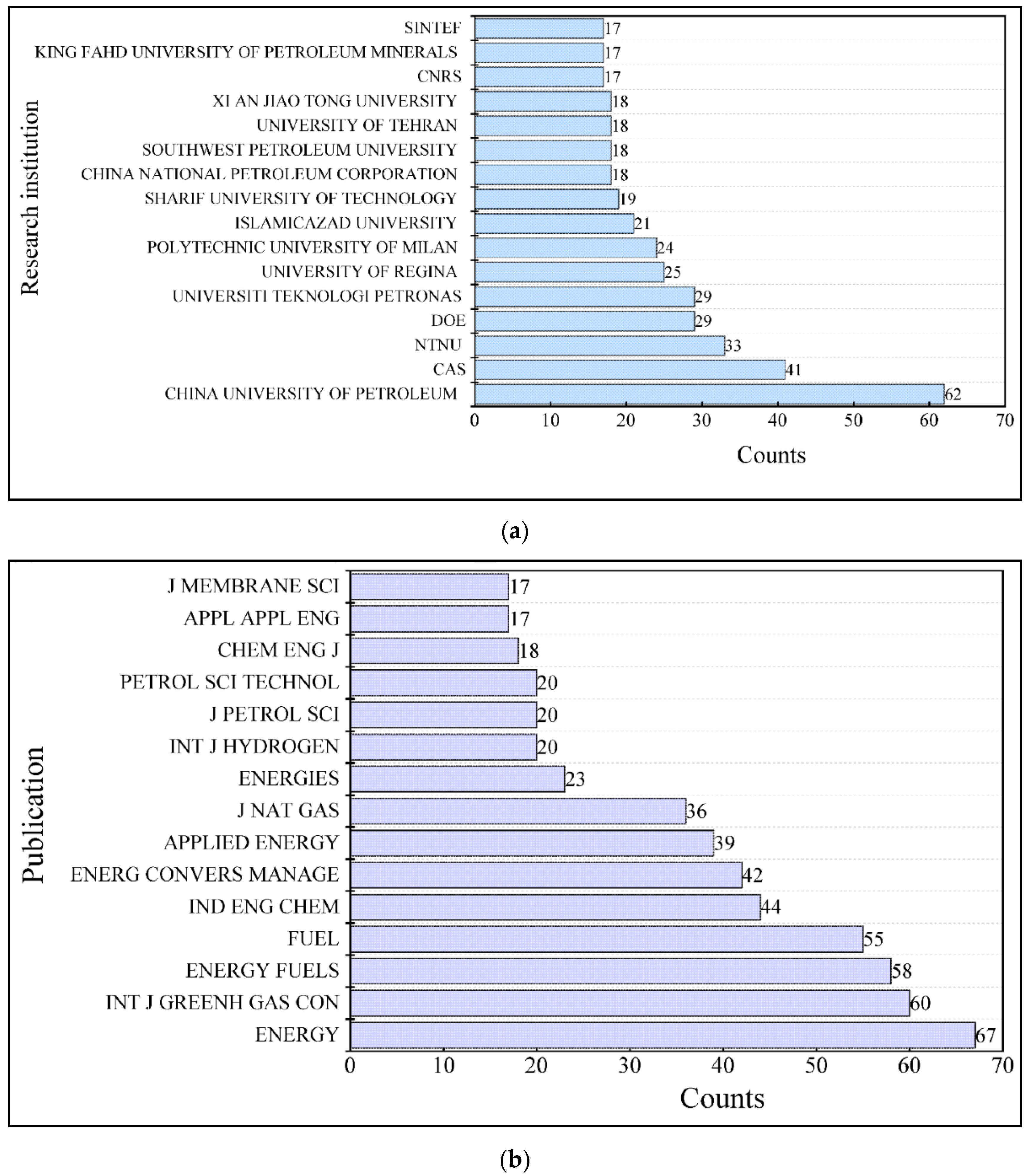
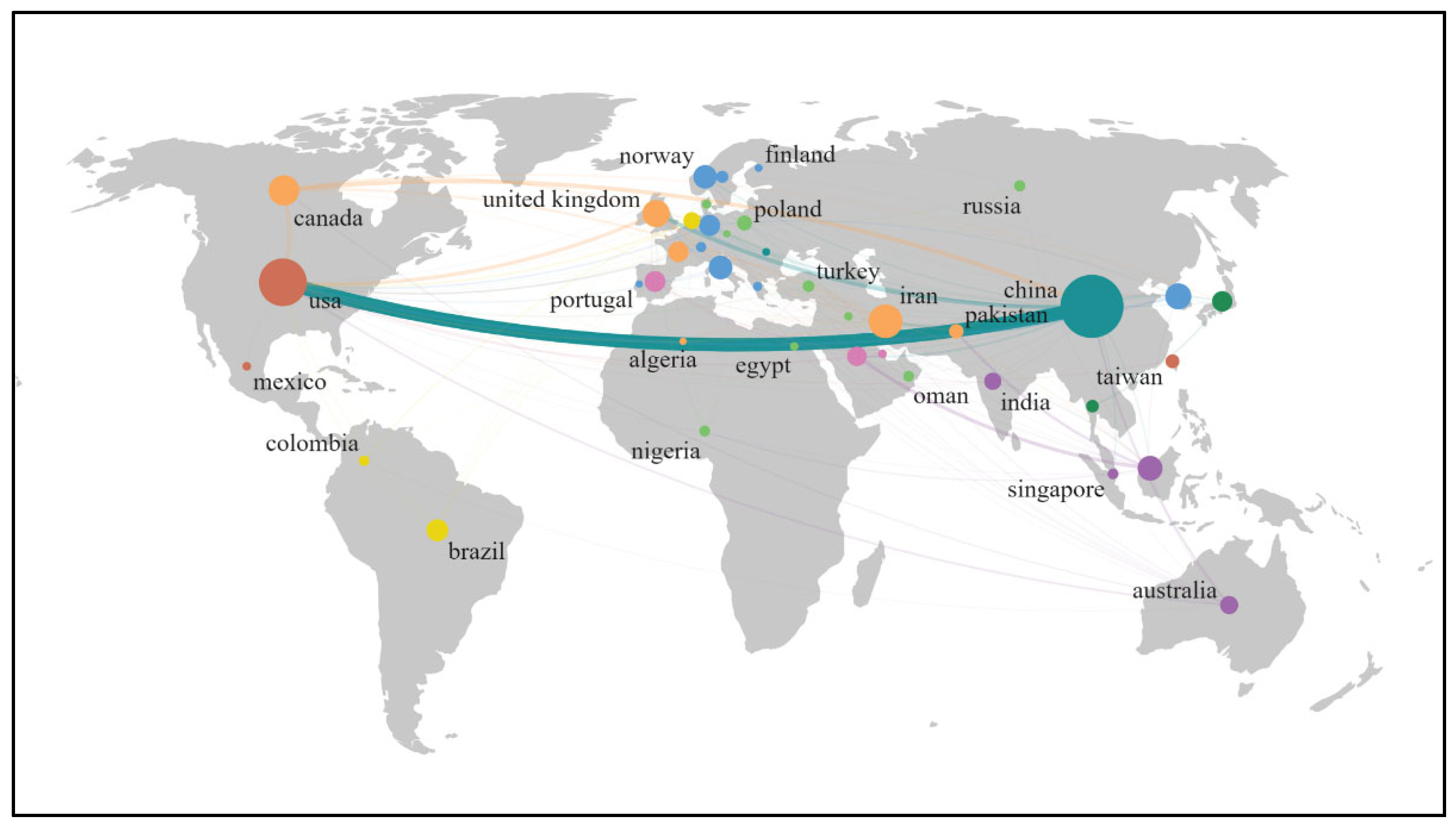

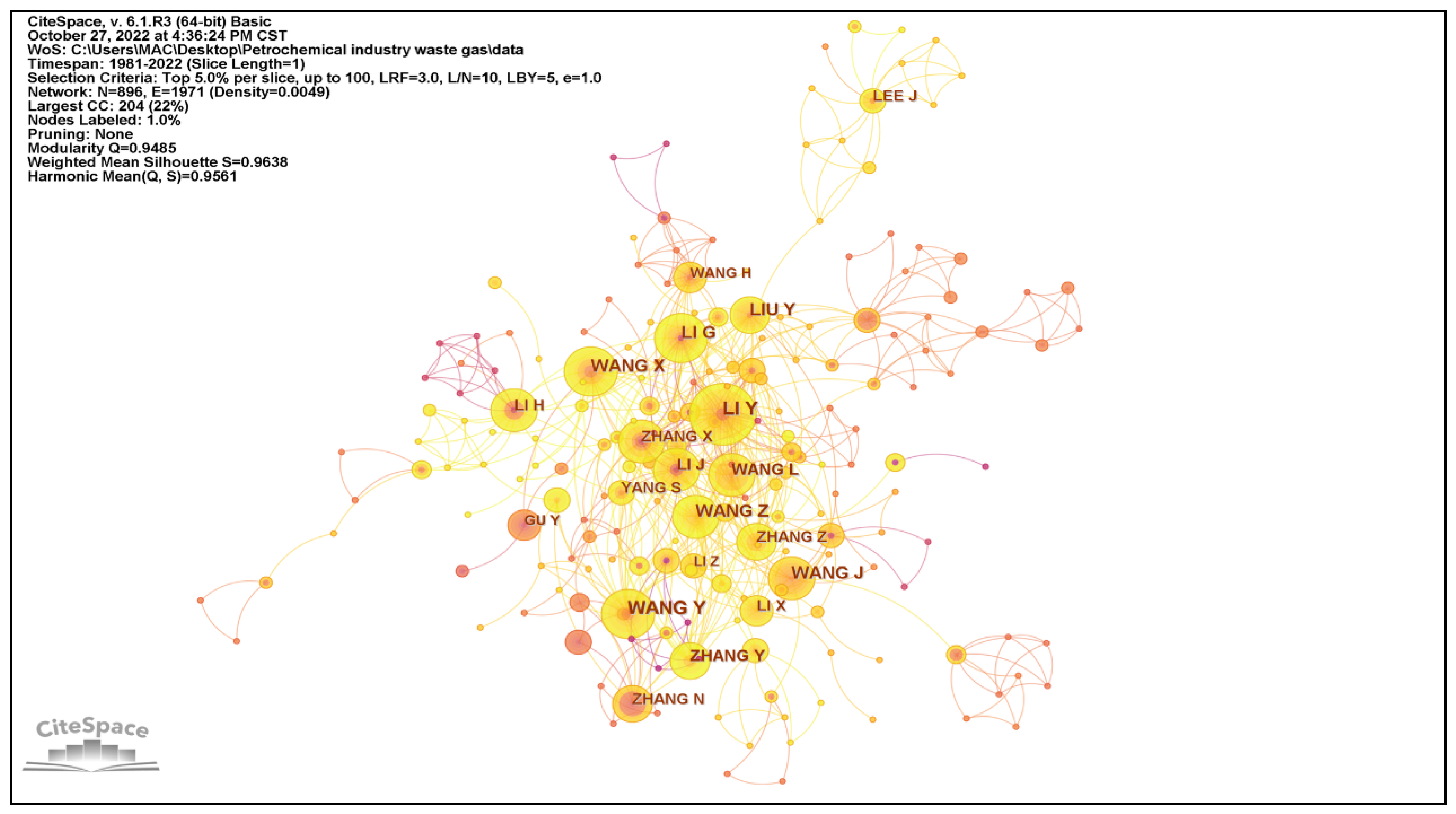
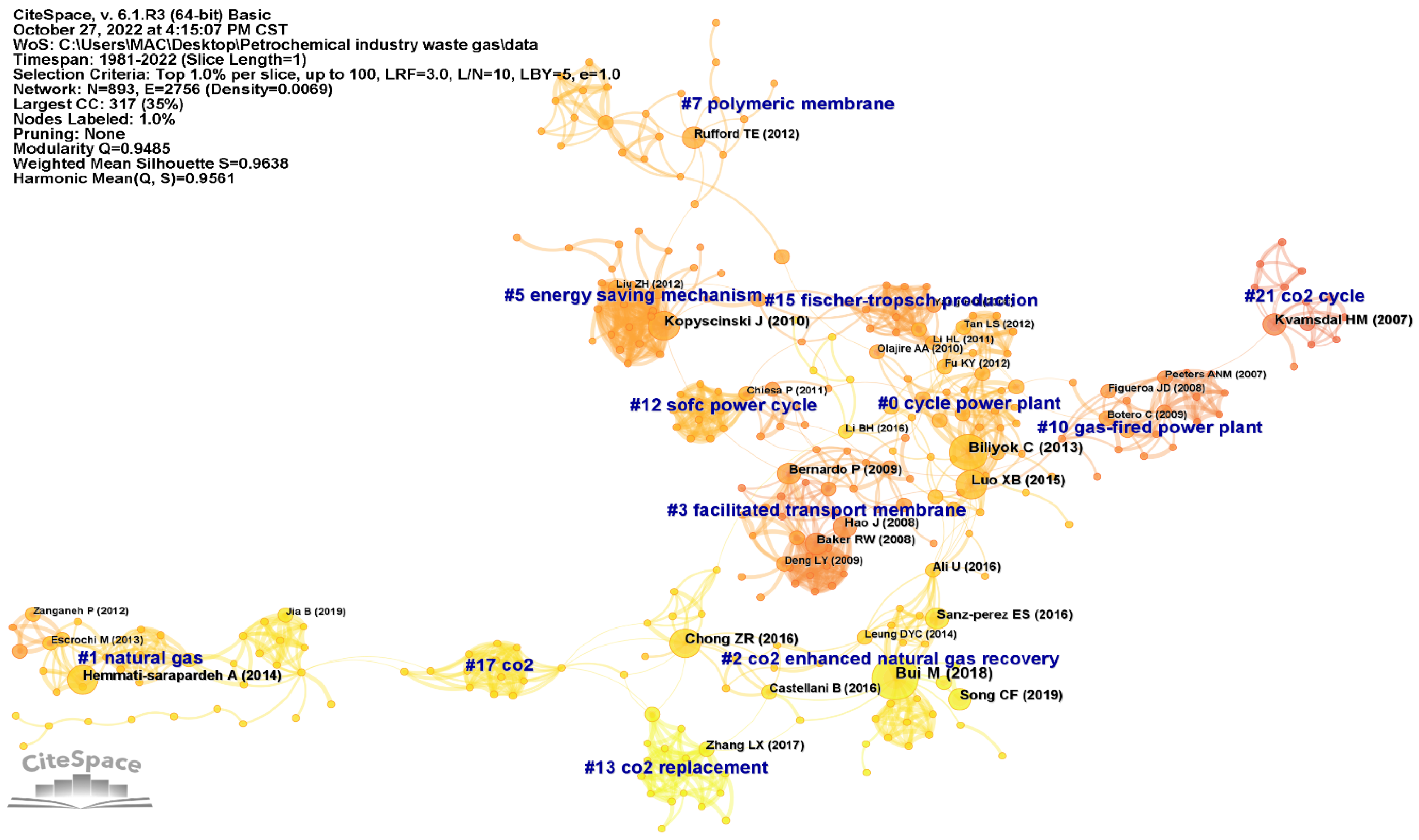
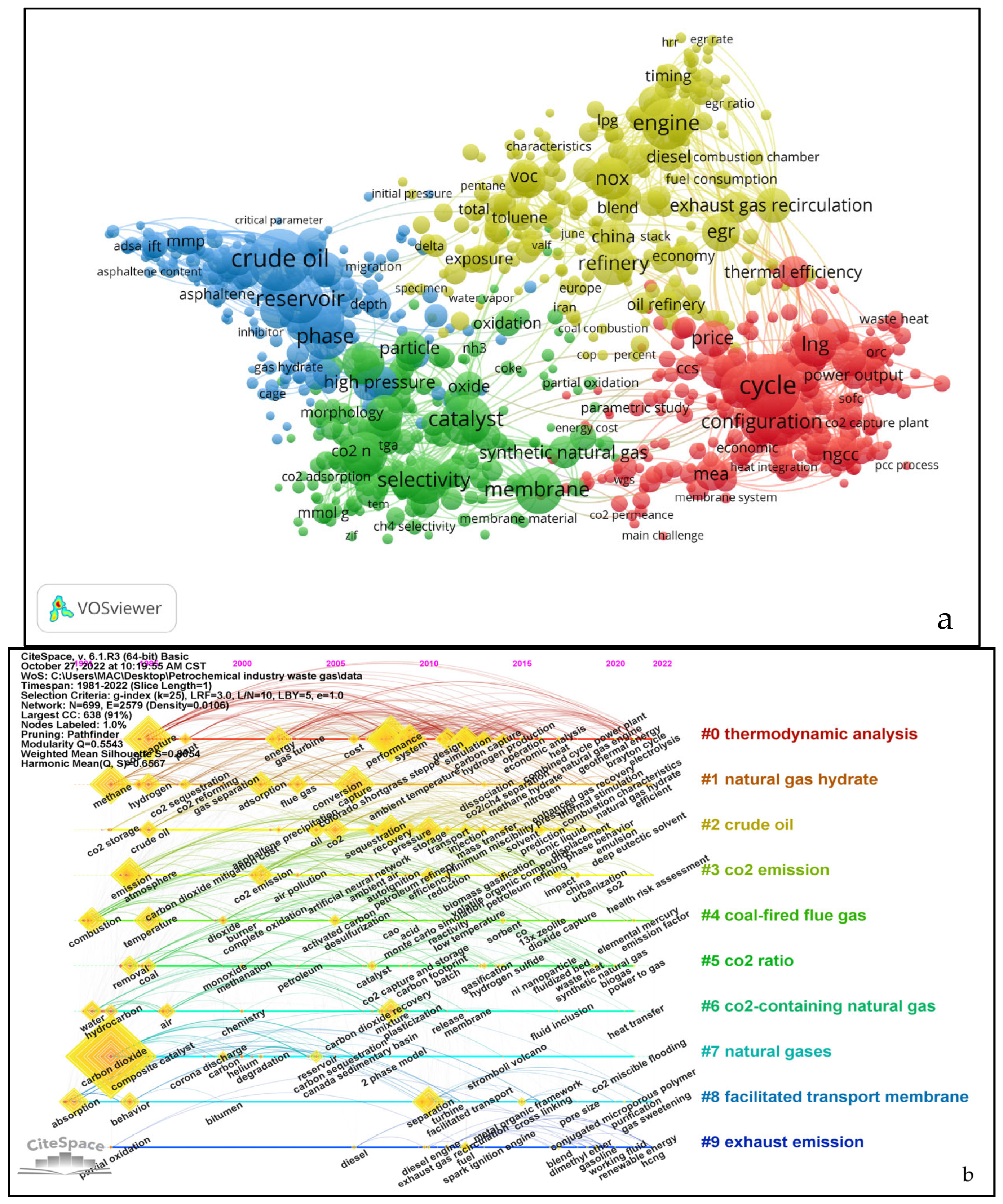
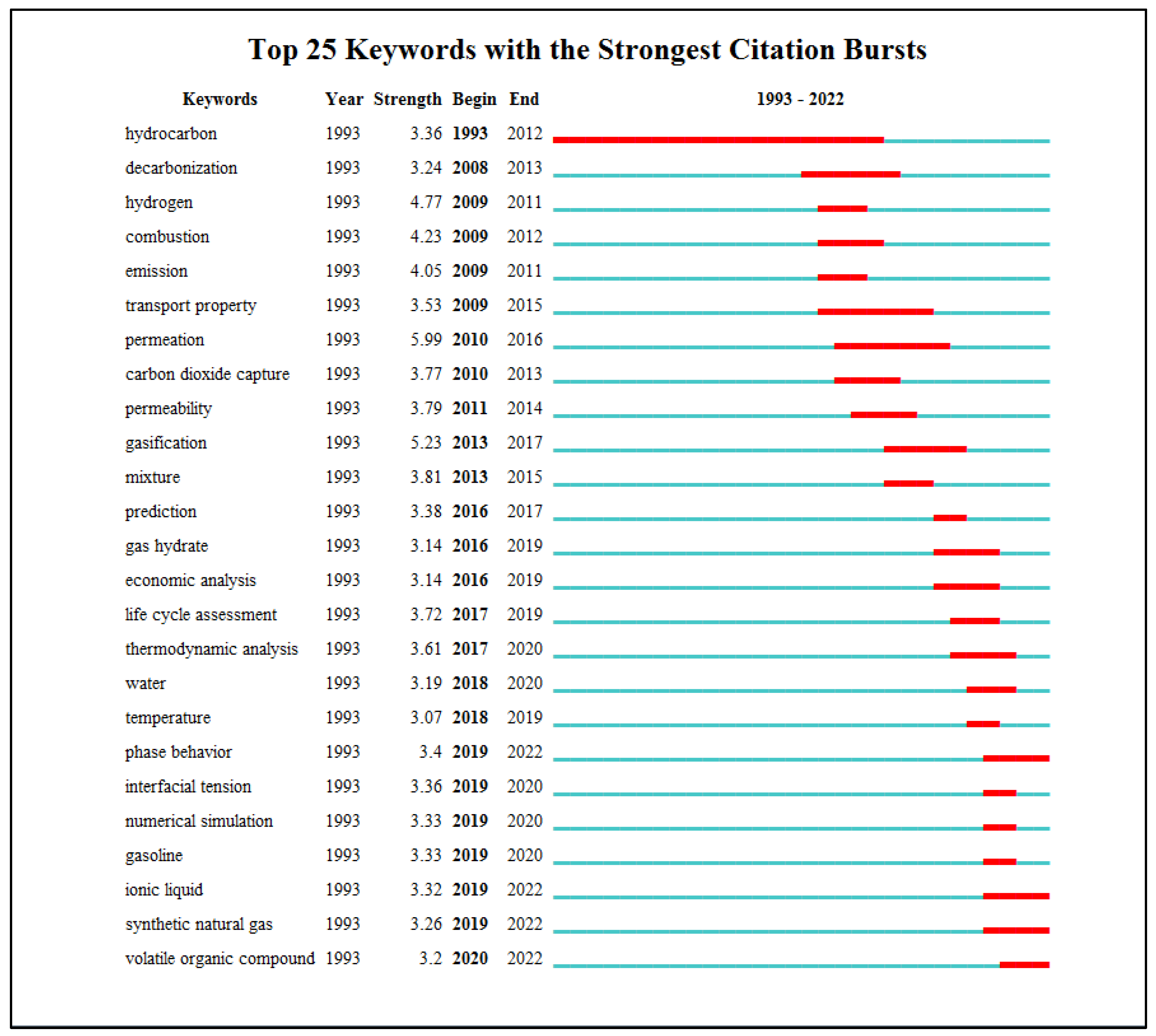
| No. | Country | TA | TCN | CPA | H-Index | Centrality | CA |
|---|---|---|---|---|---|---|---|
| 1 | Peoples R China | 375 | 8464 | 23.35 | 50 | 0.15 | 7201 |
| 2 | United States | 225 | 8598 | 38.67 | 55 | 0.34 | 7426 |
| 3 | Iran | 108 | 1901 | 18.01 | 25 | 0.18 | 1659 |
| 4 | Canada | 90 | 3205 | 36.14 | 32 | 0.17 | 2820 |
| 5 | England | 71 | 2056 | 29.48 | 26 | 0.2 | 1844 |
| 6 | South Korea | 66 | 1359 | 20.79 | 23 | 0.02 | 1254 |
| 7 | Malaysia | 58 | 1343 | 24.03 | 22 | 0.08 | 1203 |
| 8 | Italy | 54 | 1304 | 24.85 | 22 | 0.07 | 1058 |
| 9 | Norway | 54 | 2165 | 40.96 | 27 | 0.04 | 1815 |
| 10 | Brazil | 45 | 581 | 13.4 | 15 | 0.02 | 525 |
| No. | Journal | TC | CPA | H-Index | Percentage(%) |
|---|---|---|---|---|---|
| 1 | Energy | 2160 | 31.93 | 26 | 14.44 |
| 2 | International Journal of Greenhouse Gas Control | 2345 | 39.7 | 27 | 12.55 |
| 3 | Energy Fuels | 1735 | 30.34 | 22 | 12.13 |
| 4 | Fuel | 1061 | 19.49 | 19 | 15.51 |
| 5 | Industrial Engineering Chemistry Research | 1123 | 25.69 | 19 | 9.21 |
| 6 | Energy Conversion and Management | 1407 | 33.83 | 22 | 8.79 |
| 7 | Applied Energy | 1700 | 44.28 | 28 | 8.16 |
| 8 | Journal of Natural Gas Science and Engineering | 533 | 15.17 | 13 | 7.53 |
| 9 | Energies | 328 | 14.39 | 9 | 4.81 |
| 10 | International Journal of Hydrogen Energy | 690 | 34.7 | 13 | 4.18 |
| No. | Institution | TA | TC | CPA | H-Index | Centrality |
|---|---|---|---|---|---|---|
| 1 | China University of Petroleum | 63 | 1627 | 26.19 | 16 | 0.05 |
| 2 | Chinese Academy of Sciences | 41 | 1367 | 33.34 | 21 | 0.06 |
| 3 | Norwegian University of Science Technology NTNU | 33 | 1475 | 44.15 | 23 | 0.02 |
| 4 | United States Department of Energy DOE | 29 | 1300 | 44.83 | 20 | 0.00 |
| 5 | Universiti Teknologi Petronas | 29 | 622 | 21.45 | 15 | 0.01 |
| 6 | University of Regina | 25 | 747 | 29.88 | 14 | 0.02 |
| 7 | Polytechnic University of Milan | 24 | 808 | 33.67 | 16 | 0.00 |
| 8 | Islamic Azad University | 21 | 272 | 12.95 | 8 | 0.00 |
| 9 | Sharif University of Technology | 19 | 457 | 24.05 | 12 | 0.00 |
| 10 | China National Petroleum Corporation | 18 | 201 | 11.17 | 6 | 0.00 |
| No. | Authors | TA | TCN | TC | CPA | H-Index | Centrality | Country |
|---|---|---|---|---|---|---|---|---|
| 1 | Koros WJ | 21 | 155 | 159 | 19.88 | 7 | 0.01 | United States |
| 2 | Zhang ZH | 18 | 141 | 142 | 17.75 | 6 | 0.01 | China |
| 3 | Jin HG | 17 | 347 | 356 | 39.56 | 7 | 0.01 | Italy |
| 4 | Chiesa P | 17 | 26 | 30 | 6 | 3 | 0.01 | South Korea |
| 5 | Pourkashanian M | 17 | 38 | 42 | 7 | 3 | 0.01 | England |
| 6 | Bustam MA | 16 | 275 | 380 | 54.29 | 6 | 0.02 | Malaysia |
| 7 | Ahmad AL | 14 | 40 | 40 | 6.67 | 3 | 0 | Malaysia |
| 8 | Dai YP | 14 | 219 | 229 | 32.71 | 3 | 0.01 | China |
| 9 | Chavadej S | 14 | 24 | 24 | 3.43 | 3 | 0 | Italy |
| 10 | Gundersen T | 13 | 148 | 149 | 29.8 | 4 | 0.01 | Norway |
| Rank | Author | Year | Title |
|---|---|---|---|
| 1 | Bui M | 2018 | Carbon capture and storage (CCS): the way forward. [51] |
| 2 | Song CF | 2019 | Cryogenic-based CO2 capture technologies: State-of-the-art developments and current challenges. [52] |
| 3 | Biliyok, Chet | 2022 | Performance of an amine-based CO2 capture pilot plant at the Fortum Oslo Varme Waste to Energy plant in Oslo, Norway. [3] |
| 4 | Kopyscinski J | 2010 | Production of synthetic natural gas (SNG) from coal and dry biomass—A technology review from 1950 to 2009. [50] |
| 5 | Zheng YF | 2022 | Interface-Enhanced Oxygen Vacancies of CoCuOx Catalysts In Situ Grown on Monolithic Cu Foam for VOC Catalytic Oxidation. [53] |
| 6 | Luo XB | 2015 | Modelling and process analysis of hybrid hydration–absorption column for ethylene recovery from refinery dry gas. [54] |
| 7 | Huang YZ | 2022 | Mobile monitoring of VOCs and source identification using two direct-inlet MSs in a large fine and petroleum chemical industrial park. [55] |
| 8 | Zhao Y | 2008 | Primary air pollutant emissions of coal-fired power plants in China: Current status and future prediction. [49] |
| 9 | Singh P | 2017 | Current and emerging trends in bioremediation of petrochemical waste: A review. [56] |
| 10 | Yuan ZH | 2017 | Smart Manufacturing for the Oil Refining and Petrochemical Industry. [57] |
Disclaimer/Publisher’s Note: The statements, opinions and data contained in all publications are solely those of the individual author(s) and contributor(s) and not of MDPI and/or the editor(s). MDPI and/or the editor(s) disclaim responsibility for any injury to people or property resulting from any ideas, methods, instructions or products referred to in the content. |
© 2024 by the authors. Licensee MDPI, Basel, Switzerland. This article is an open access article distributed under the terms and conditions of the Creative Commons Attribution (CC BY) license (https://creativecommons.org/licenses/by/4.0/).
Share and Cite
Wu, M.; Liu, W.; Ma, Z.; Qin, T.; Chen, Z.; Zhang, Y.; Cao, N.; Xie, X.; Chi, S.; Xu, J.; et al. Global Trends in the Research and Development of Petrochemical Waste Gas from 1981 to 2022. Sustainability 2024, 16, 5972. https://doi.org/10.3390/su16145972
Wu M, Liu W, Ma Z, Qin T, Chen Z, Zhang Y, Cao N, Xie X, Chi S, Xu J, et al. Global Trends in the Research and Development of Petrochemical Waste Gas from 1981 to 2022. Sustainability. 2024; 16(14):5972. https://doi.org/10.3390/su16145972
Chicago/Turabian StyleWu, Mengting, Wei Liu, Zhifei Ma, Tian Qin, Zhiqin Chen, Yalan Zhang, Ning Cao, Xianchuan Xie, Sunlin Chi, Jinying Xu, and et al. 2024. "Global Trends in the Research and Development of Petrochemical Waste Gas from 1981 to 2022" Sustainability 16, no. 14: 5972. https://doi.org/10.3390/su16145972






